A Short History of RUSSIA
This article is a summary of the book “A Short History of Russia: From the Pagans to Putin” written by Mark Galeotti in 2020. I wanted to share its key takeaways that help understand modern-day Russia.
Each section of this article contains a “Timeline” part and an “Analysis” part. The information provided here are only those of the author.
Very (very) short history of Russia i.e. what to really remember from this book🤔
9th-12th centuries : birth of the Rus’ nation plagued by dynastic struggles
13th-15th centuries : Mongolian domination
- Myth of the “Mongolian yoke” according to which Mongolians delayed the modernisation of Russia whereas Russian princes’ selfishness and a lack of territorial cohesion greatly explain it.
- Mongolians allowed Moscow to become the heart of Russia, instead of Kiev and Novgorod.
15th-16th centuries: Ivan III and Ivan IV “The Terrible”
- Establishment of a strong central power (creation of a State apparatus from scratch) to unify Russian lands because internal divisions were seen as the origin of external threats.
- Ivan IV “The Terrible” (ruled 1533-1584) was the 1st Tzar of the Russian Empire. He was paranoid and developed political surveillance.
- Substantial territorial expansion eastwards with colonies in Siberia.
17th-early 20th century: the Romanov dynasty
- Peter the Great (ruled 1682-1725) and Catherine II (ruled 1762-1796) tried, though only superficially, to turn Russia into a European nation.
- Nicolas I (1825-1855) turned Russia into Europe’s policeman.
- Alexandre II (1855-1881) undertook ambitious social reforms like the abolition of serfdom.
- Nicolas II (1894-1917) was a poor leader that was defeated against Japan and during the First World War.
20th century: The Soviet Union
- Lenin led the October 1917 communist revolution and fought a civil war until 1922.
- Stalin (ruled 1922-1953) turned the USSR into a totalitarian State and initiated the industrialisation of the country without any consideration for its human cost.
- The Great Patriotic War (1941-1945) killed 27 million Russians and the USSR portrayed itself as Europe’s saviour.
- The fall of the Berlin Wall in 1989 symbolised the USSR’s defeat against the US in the Cold War and subsequently Gorbachev (ruled 1985-1991) announced the dissolution of the USSR in 15 republics.
21st century: Vladimir Putin
- Thanks to economic growth in the 2000s, the population accepted his authoritarian style.
- He’s been building Russia’s national identity in opposition to the West and launched several military operations abroad in order to defend Russia and its “near abroad” (former Soviet Republics) against the West’s attempts to isolate and destabilise it.
I. ‘Let us seek a prince who may rule over us’ (9th to 12th centuries)
A. Timeline
862: Arrival of Ryurik, birth of the new Rus’ nation

Ryurik managed to unite clans and tribes in the North of today’s Russia. He established Novgorod as the capital-city. He conducted raids using rivers in order to expand his territorial possessions southward and eastward.
882: Oleg takes Kiev and moves his capital there from Novgorod
Kiev remained the capital city of the Rus nation during centuries. Its prosperity was such that Constantinople, that it tried to attack several times in vain, respected it in the sense that it didn’t look down on it.
980: Vladimir the Great becomes Grand Prince of Kiev
Vladimir the Great was an empire builder and unlike his predecessors was more a politician than a fighter. He sought to unite the Rus’ and make them transcend their Scandinavian roots that dated back to Ryurik.
988: Vladimir decrees conversion to Orthodox Christianity
At the time, paganism and Christianity coexisted but the latter was already progressively replacing the former. Vladimir made his decision partly in order to strengthen trade connections with Constantinople. As of this moment, religion took on an influential role in the dynamics of the Russian State.
1015: Vladimir’s death triggers dynastic struggles
Despite Vladimir’s unification efforts, the country was divided into various princedoms that pursued their own interests and didn’t feel connected to each other.
Dynastic struggles allowed the Polish to seize some western Russian cities, to meddle with internal Russian affairs and eventually sack Kiev in 1018.
1036: Yaroslav the Wise controls all the Rus’ lands
This was a period of economic prosperity characterised by deep connections with Constantinople, the Arab world and northern peoples.
1054: Yaroslav’s death triggers dynastic struggles
1097: Establishment of a feudal system at the Lyubech conference
1113: Vladimir Monomakh becomes Grand Prince at the request of the people of Kiev
B. Analysis
When we look back at this period, we should bear in mind that the Russian territory was crossed by trade routes that connected Europe and Asia. Hence, it benefited from the circulation of wealth and ideas. However, this central location turned Russia into an obvious target for any empire that sought to expand.
During the entire 12th century, the Russian State was fragmented in small princedoms and from this period on Russian leaders’ core thought has been that danger comes from division. It is the idea that internal divisions weaken the State and expose it to external threats. Therefore, any kind of opposition to Moscow’s central power is judged as anti-patriotic.
The author also highlights the fact that China is today’s Constantinople from a Russian perspective as it is both a source of fear and a source of inspiration.
II. ‘For our sins, there came an unknown tribe’ (13th to 15th centuries)
A. Timeline
1237-1240: Mongolian invasion of Russia by Genghis Khan
1240: Kiev falls under Mongolian rule
Mongolians established the Golden Horde, which was a subdivision of the vast Mongolian empire, so as to administer Russian territories. Sarai became the capital-city of the Golden Horde. Nevertheless, Russian princes maintain a great deal of leeway in their own governance choices.

1267: The Golden Horde grants privileges to the Russian Orthodox Church
Under Mongolian rule, Russian territories experienced religious tolerance and economic prosperity.
1325: Ivan I Kalita becomes prince of Moscow
The Mongolians supported Ivan I in his endeavour to make Moscow prosper. Progressively, the city accumulated wealth and became the heart of Russia.
1352-1360: The plague wreaks havoc in Russia, killing around 25% of its population
1359: Dimitri Ist Donskoi becomes prince of Moscow
1380 : Battle of Koulikovo between Dimitri of Moscow and the Golden Horde
Dimitri Ist Donskoi came out victorious and since then Koulikovo is regarded as the sanctuary of Russian nationalism. However, this battle was far from being decisive because the Golden Horde quickly got back on its feet and sacked Moscow two years later…
1382 : Khan Tokhtamich sacks Moscow
1462 : Ivan III the Great becomes prince of Moscow
1480 : Great stand on the Ugra River and end of the Golden Horde’s ruling
Ivan III defied the Golden Horde and beat it at the Ugra river. He then proceeded to gather Russian lands but rivalries between Russian princes never stopped.
B. Analysis
The period under the Golden Horde has been described as the “Mongolian yoke” because it allegedly prevented Russia from experiencing the wave of cultural, social, economic and religious changes that swept across Europe during the Renaissance. Besides, it is commonly thought that Russia’s culture of despotism stems from the Mongolian era.
However, this vision of history contains several inaccuracies.
As a matter of fact, the Golden Horde didn’t try to impose its culture (except maybe during the 13th century when Mongols adopted Islam) and its administration of Russian territories relied on Russian princes, who were the only channels through which Mongols could influence Russian populations. Moreover, connections with Europe were maintained during the Mongolian rule and the isolation of the country during the Renaissance is also due to its poverty and its underdeveloped East-West transport infrastructure.
We should also bear in mind that it is only through the Mongols’ intervention that Moscow, which was a small town when Kiev and Novgorod were at their peak, could turn into the heart of modern Russia.
As for why authoritarianism seems to be such a central element of Russia’s political culture, we can say that Russia is a large country that needs a strong central power in order to keep it united and quell any autonomous aspirations.
III. ‘Autocracy, by God’s will’ (16th century)
A. Timeline
1497 : Adoption of a Code of Law (Sudebnik)
This Code of Law reduced the Russian population’s freedoms but increased Ivan III’s powers. The latter also established a strong central power in order to prevent internal divisions, especially between different noble families and clans. That’s why the State took possession of princedoms, abolished hereditary power as well as any kind of independence from the central government.
1533 : Ivan IV the Terrible becomes prince of Moscow at the age of three
Probably due to a difficult childhood, Ivan IV developed an obsession for creating safe zones around him, whether they were physical, political or moral. He quickly turned paranoid and the brutality with which he treated conspirators and potential enemies created a climate of terror within the various circles of power. He is thought to be at the origin of the creation of political commissioners.
1547 : Ivan IV the Terrible becomes Tzar of Russia
He became emperor with a divine mandate, under the sole judgement of God.
1549 : First Zemsky Sobor
It is a parliament comprising the Nobility, the Church and commoners. It could be summoned by the Tzar, the patriarch or the council of the Nobility to discuss major decisions for the country.
1550 : New Code of Law (Sudebnik) and formation of Streltsy
Ivan IV’s the Terrible centralised even more power in his hands and created from scratch a State apparatus for administering the country.
Besides, the Nobility became dependent on the State for its survival as lords (“boyars”) had to work at its service and their status at the court relied on the quality of the service rendered.
The Tzar also turned a feudal army into a permanent monarchical one made up of infantry mercenaries fully at the service of the State (Streltsy).
1551-1553 : Conquest of the Khanate of Kazan

Ivan IV’s imperial ambitions created a new enemy for the Russian empire as tensions increased with the Ottoman Empire that also had views on territories between the Black Sea and the Caspian Sea. That’s why the first of a long series of wars between the two empires broke out in 1559.
The Russian empire also found enemies in Sweden, Lithuania, Poland and Denmark around the question of the access to the Baltic Sea.
Nevertheless, the real expansion of Russia took place in Siberia that became a colony and whose conquest and administration was delegated to the rich Stroganov family.
During the following century, the Russian empire expanded by 35,000 km² every year (almost the size of the Netherlands)

1565-1572 : The Oprichnina
The Oprichnina was a State within the Russian State and in which Ivan the IV had absolute powers. The Opritchniks (his personal guards) executed his orders all over Russia but with total impunity committed various crimes and abuses, which was a source of concern for Ivan IV.
The rest of the country (Zemshchina) was under the administration of the Nobility.
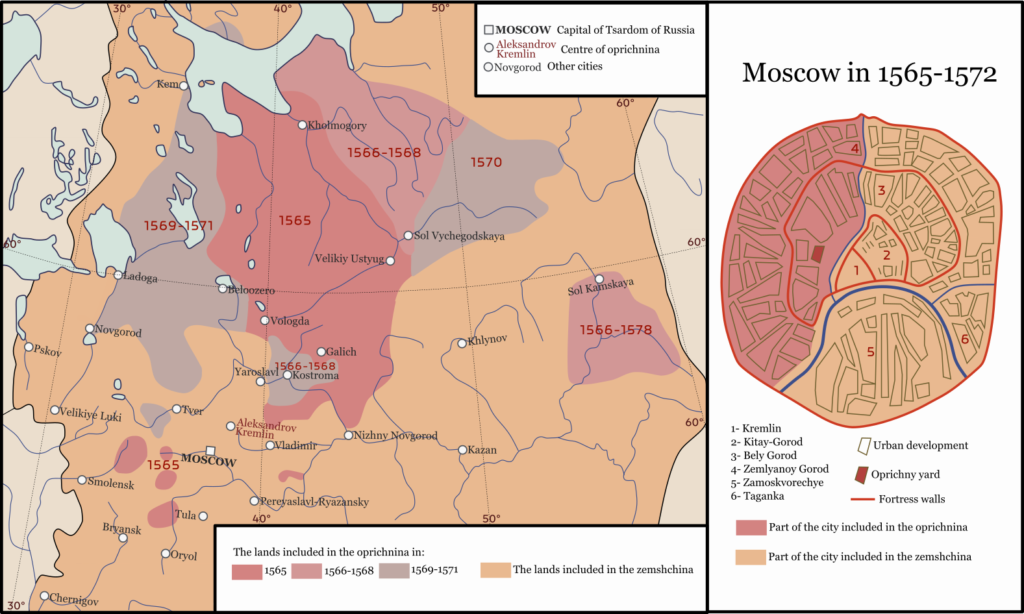
However, the division of the country between the Oprichnina and the Zemshchina brought great instability and, in 1572, Ivan got back to power in Moscow and dissolved the Opritchiniks.
1584 : Death of Ivan IV the Terrible
Multiple crisis characterised the end of his reign and he left the country’s economy in shambles.
Fedor I “The Blessed” was Ivan IV’s only heir as he killed his other son Ivan in an excess of rage.

1605-1613 : The Time of Troubles
During this period, Russia was plagued by internal rivalries, rebellions, coups, invasions and so on. External threats comprised the Tatars from Crimea, the Ottomans from the South and the Polish and Swedish from the West.
Russians then realised that they needed a strong leader in order to prevent the country from falling into chaos and assure a stable future for the country.
1613 : Michel Romanov is chosen by the Zemsky Sobor as the new Tzar of Russia
Since the death of Ivan IV’s, the Romanov family started heavily influencing imperial institutions. Michel Romanov’s rise to power marked the beginning of a new dynasty that would lead Russia until the 1917 Revolution.
B. Analysis
Ivan IV the Terrible and his grand-father Ivan III were the ones who laid the foundations of the modern Russian State. They created the ideological and institutional framework of Russian autocracy by divine right.
IV. ‘Money is the artery of war’ (17th and 18th centuries)
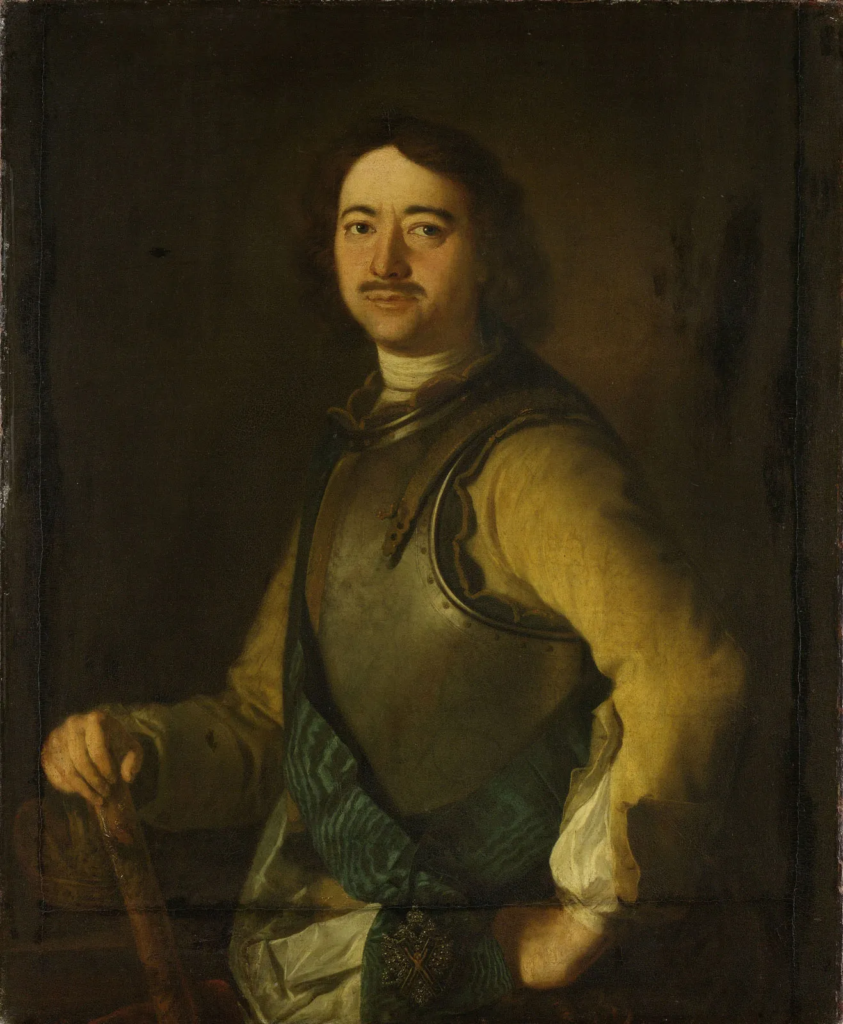
A. Timeline
1639 : The Russians reach the Pacific Ocean
1649 : Reduction of the Church’s privileges under a new Code of Law (Sobornoe Oulojenie)
1652-1666 : Nikon becomes the patriarch of the Russian Orthodox Church
With a fundamentalist approach, Nikon strove to cleanse the Russian Orthodox Church and revive its Greek-Byzantine origins (with many approximations though) through terror.
Nikon had a great deal of influence on Tzar Alexis, the son of Michel Romanov, and managed to circumvent the Sobornoe Oulojenie.
1654-1667 : First war of the North against Poland and Sweden
1667-1671 : Cossack rebellion led by Stenka Razine
1682 : Abolition of the Mestnitchestvo
This system had established that aristocrats’ role in society was defined by their birth and social status. With its abolition, one’s role and position became based on the services one could render to the State.
1682 : Peter the Great becomes co-Tzar at the age of 9
1696 : Peter the Great is now the only Tzar in Russia
1697-1698 : “Great embassy” of Peter the Great in Europe
Peter the Great wanted Russia to be a European nation and sought to adopt Western ideas and technologies. However, most of his reforms were only superficial: shaving one’s beard, having civil servants wear European clothes, adopting a calendar starting on Jesus Christ’s birthdate… He didn’t actually manage to turn Russians into Europeans and change their way of thinking.
In 1697-1698, he travelled to Europe (Sweden, the Netherlands, England, Germany and Austria) and, at his return, he initiated the construction of the new Russian capital city: Saint Petersburg. It was inspired by Dutch and English plans, designed by Italian, French and German architects and built by half a million serfs of whom several dozens of thousands died.
1700-1721 : Great War of the North against Sweden won by the Russian Empire
Military subjects interested Peter the Great on a personal level but he also understood the importance of having a powerful army to make Russia a great and respected nation. Therefore, he undertook reforms to standardise military equipment, professionalise officers and build up a proper navy.
With the Great War of the North, the Russian Empire proved that it was able to sustain logistically a long and difficult war.
1722 : Adoption of the Table of the ranks
In the same logic as the abolition of the Mestnitchestvo, nobles who wanted to rise within the State hierarchy had to go through 14 ranks based on their competencies and the services they rendered to the State. In practice, birthplace, wealth and relations still played a major role in one’s professional and social position.
1722-1723 : Military campaign in Persia
1725 : Death of Peter the Great
B. Analysis
Russian Tzars have long sought to protect their borders, defend their interests and maintain stability within the State, without adopting Western technologies that required carrying out social and political reforms. However, Russia needed foreigners’ money, technologies and military experience. Furthermore, just like Peter the Great, many Russian elites were attracted by the European culture, which explains their willingness to discover and appropriate it. Though, most of the population remained poor and lived off agriculture in a feudal system.
The 17th century in Russia was characterised by wars abroad, internal rebellions but also further territorial expansions and a growing national pride.
Peter the Great was a practical and pragmatic leader who understood that an underdeveloped and outdated Russia was vulnerable. By the end of his reign, he had turned it into a power that Europe could not ignore. Nonetheless, he failed to properly modernise Russians’ way of thinking and behaviour, which Catherine the Great would take care of 50 years later.
V. ‘I shall be an autocrat: that’s my trade’ (18th century)
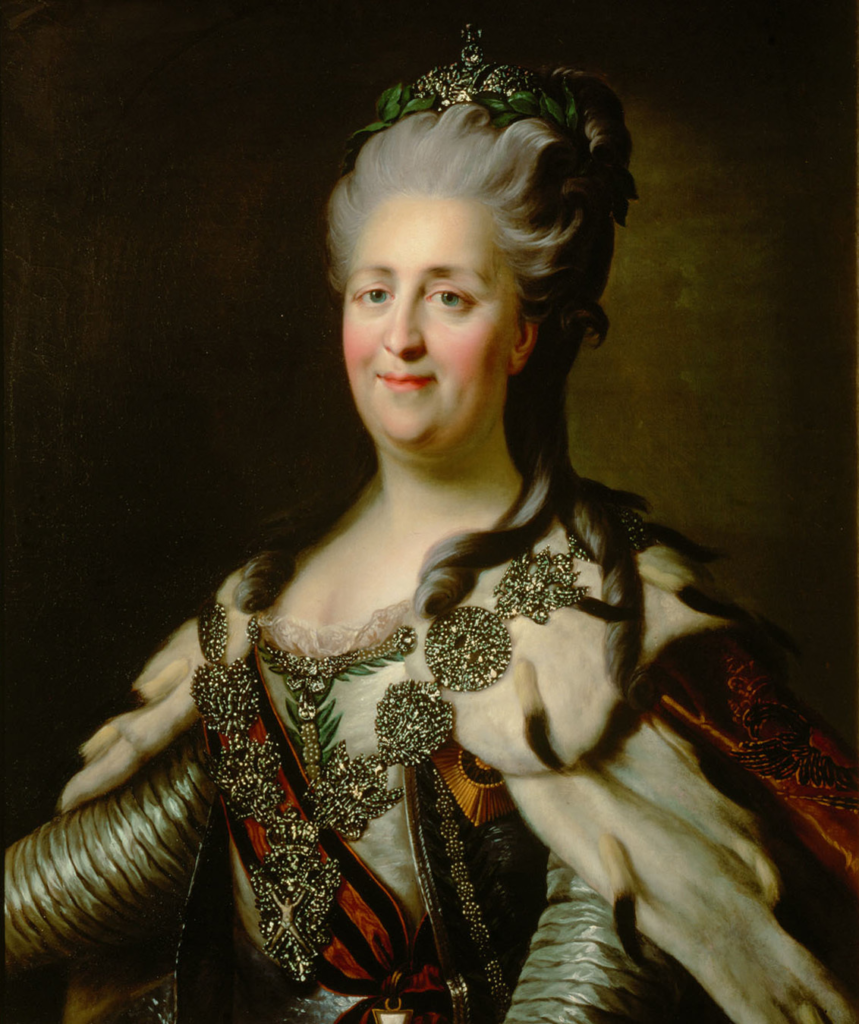
A. Timeline
1725 : Death of Peter the Great and coup d’État by his wife Catherine I
1741 : Coup d’État by Elizabeth the daughter of Peter the Great
After several years of wavering and quarrels to know who would be the next Russian leader, Elizabeth seized power in a coup. It would appear that through “elegance” and “diplomacy” she succeeded to impose Russia as a European power.
1762 : Coup d’État by Catherine II the Great against her husband Peter
She was a Prussian princess named Sophie Frederic Augusta von Anhalt-Zerbst-Dornburg.
1767 : Convening of the legislative commission
This commission gathered representatives of all social communities, except for the serfs. Catherine II asked them to discuss the elaboration of a new Code of Law that would enshrine the principles of legality, equality and absolutism. She wanted to be the epitome of the “enlightened despot”, though she was more despot than enlightened.
Nevertheless, the commission was too heterogenous and underqualified to propose anything to the Empress. Despite this setback, Catherine II the Great got to hear her population’s concerns and set the priorities for her future policies accordingly.
1768-1774 : War and victory against the Ottoman Empire
1773-1774 : Rebellion led by Pougatchev
1783 : Annexation of Crimea that belonged to the Ottoman Empire
1785 : Charter granted to the Nobility
Catherine II the Great realised that the hypercentralisation of the State around one supreme leader could be a source of inefficiency and fuel frustration and jealousy around her.
Through the Charter, she granted more powers to the Nobility on their lands and serfs even though its weight in rural areas, the army and the public administration was already quite significant.
In parallel, she started creating intermediary institutions for local administration and daily affairs. She also gave more powers to cities and paved the way for the emergence of local governments.
1787-1792 : War and victory against the Ottoman Empire
1788-1790 : War against Sweden
1796 : Death of Catherine II the Great
Her son Paul I became Tzar (1796-1801). He promulgated laws to prevent women from becoming Empresses and, contrary to Catherine II that sought to fit into the Enlightenment movement, Paul I displayed a high degree of conservatism and authoritarianism.
B. Analysis
Whereas Peter the Great focused on the army and State institutions, Catherine II the Great focused on cultural and intellectual affairs in order to transform Russia into a European power. That’s why she regularly sent letters (“belles lettres” in French) to Western philosophers of the Enlightenment like Voltaire in which her portrayal of Russia was miles away from reality.
As a matter of fact, the Europeanisation of Russia was shallow as the country was lagging behind its European counterparts in terms of manufacturing, royal court standards and literacy rate. Socially and economically, the country was still stuck in the Middle Age and hadn’t experienced the wave of changes brought by the Renaissance and the Enlightenment periods.
VI. ‘Orthodoxy. Autocracy. Nationality’ (19th century)
A. Timeline
1812 : “Patriotic War” against Napoleon
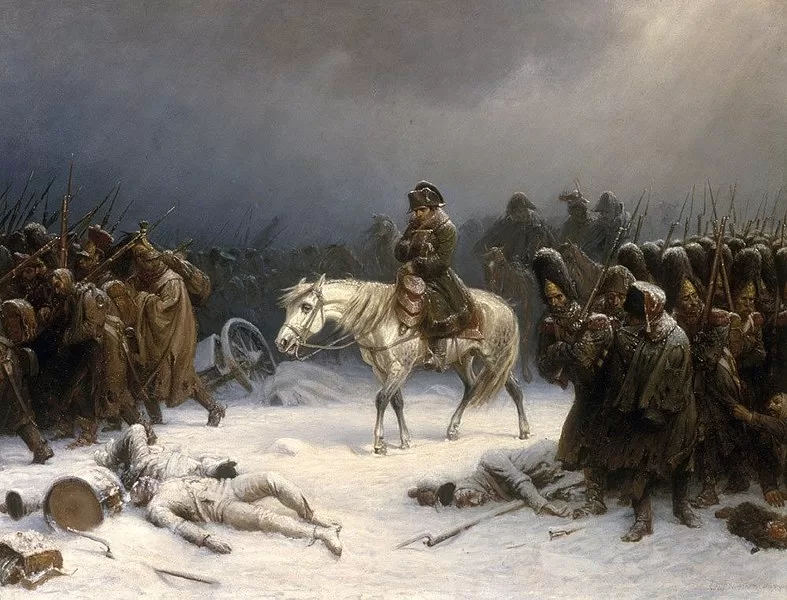
Logistical issues, winter and long distances led to the defeat Napoleon in Russia: only 25,000 soldiers out of the 685,000 that composed his army survived. However, Alexander I used this victory to prove that Russia was not weak and that the much needed political, social and economic reforms could be delayed.
1826-1828 : War against Persia
1828-1829 : War against the Ottoman Empire
Nicolas I wanted to weaken the Ottoman Empire in order to turn it into a sort of vassal and at the same time keep it alive to use it as a powerful ally to influence the balance of power in Europe. The Tzar also sought to give Russia access to the Mediterranean Sea through the Dardanelles and the Bosporus Straits.
1853-1856 : Crimean war
The war exposed how poorly equipped, trained and commanded the Russian army was.
France and Great Britain backed the Ottoman Empire. In fact, Great Britain feared Russian expansionism and France’s new leader Napoleon III was after military victories and glory.
1855 : Death of Nicolas I
During his reign, Nicolas I strove to keep his distance with the European model in order to preserve Russia’s imperial and traditional model. He felt that he had a duty to restore order against the anarchy and insurrection that originated from Europe, which justified censorship and political repression. Besides, he dedicated much of the State’s resources to the army and Russia became known as the “Gendarme of Europe” due to its willingness to help other European monarchs quell revolutionary movements, especially at the end of the 1840s.
His son Alexander II scaled down the military pretensions of the Russian Empire and focused on its modernisation. He had to deal with two opposite camps in this endeavour. On one hand, advocates for Europeanisation requested industrialisation and constitutionalism but didn’t know how it could fit Russia specifically. On the other hand, conservatives sought to protect Russia from western influence but didn’t know how to manage it along with a necessary modernisation.
1861 : Emancipation of the serfs
Throughout his reign, Nicolas I worked to abolish serfdom but realised that doing so would greatly destabilise Russia and do more harm than serfdom itself. His son however decided to take the bull by the horns and abolished serfdom, which caused multiple tensions between landlords and serfs who wanted ownership of the lands they cultivated.
In parallel, several social evolutions could be witnessed:
- the rural Nobility was assigned more responsibilities with regards to daily governance (levying taxes, rendering justice…)
- with urban development, a wealthy class of merchants emerged
- the number of public servants significantly increased
- education was made accessible to more people, who remained a minority though
Besides, the social and cultural denunciation of the Establishment gained various classes and communities and the Tzar severely repressed it, which fuelled a vicious circle as more Russians engaged into anarchist terrorist activities.
1881 : Murder of Alexander II by terrorists of the Nihilist movement
His son Alexander III replaced him and established a more authoritarian and repressive power that discriminated against minorities, especially the Jews. In order to modernise his country, Alexander III decided to tax more the peasantry… The 1891-1892 famine killed 500,000 Russians.
Alexander III died in 1894 and his son Nicolas II took over until 1917. The latter was a “conservative without imagination” who was “hesitant in his convictions” and who was simply unable to solve Russia’s growth and modernisation’s issues.

1904-1905 : War against Japan
Nicolas II believed that a military victory against Japan would appease the explosive social situation at home. However, the Russian fleet got defeated quite easily, which put an end to the war and further weakened Nicola II’s regime.
1905 : Revolution of 1905
In January 1905, 150,000 demonstrators pacifically marched in the streets of Saint-Petersburg to ask the Tzar to implement some reforms. The Tzar was absent at the time and the imperial guard panicked and opened fire. It sparked the 1905 revolution that we will discuss in the next part.
B. Analysis
Throughout the 19th century, Russia built its national identity in relation to Europe: for liberals and reformers, it had to follow the European model while for conservatives it had to reject it. As for Russian revolutionaries, European ideals stemming from the 1789 French revolution inspired them to brought about changes in Russia.
During his reign, Alexander II “The Liberating Tzar” faced two major challenges :
- He wanted liberalisation, equality before the law and constitutionalism BUT he also believed in a strong centralised State with unrestrained powers to carry out necessary modernisation reforms.
Alexander II needed the aristocracy and the State bureaucracy to implement his reforms but these two actors were those that would be affected by said-reforms and Alexander II had better not set them against him
VII. ‘Life is getting better, comrades, life is getting brighter’ (20th century)
A. Timeline
1905 : Revolution of 1905
To appease the wave of strikes and demonstrations, Nicolas II promised a new Constitution, more liberties and an elected parliament (“Duma”). However, nothing really change in the governance of the country.
1914-1918 : First World War
It was the first modern industrial war and Russia was definitely not prepared for it. Its war effort substantially damaged the economy and impoverished the population that suffered hunger.
1917 : February Revolution and end of tzarism
The garrison of the capital refused to quell hunger riots and mutinied. Besides, Nicolas II became the symbol of Russia’s military debacle and therefore decided to abdicate.
1917 : October Revolution
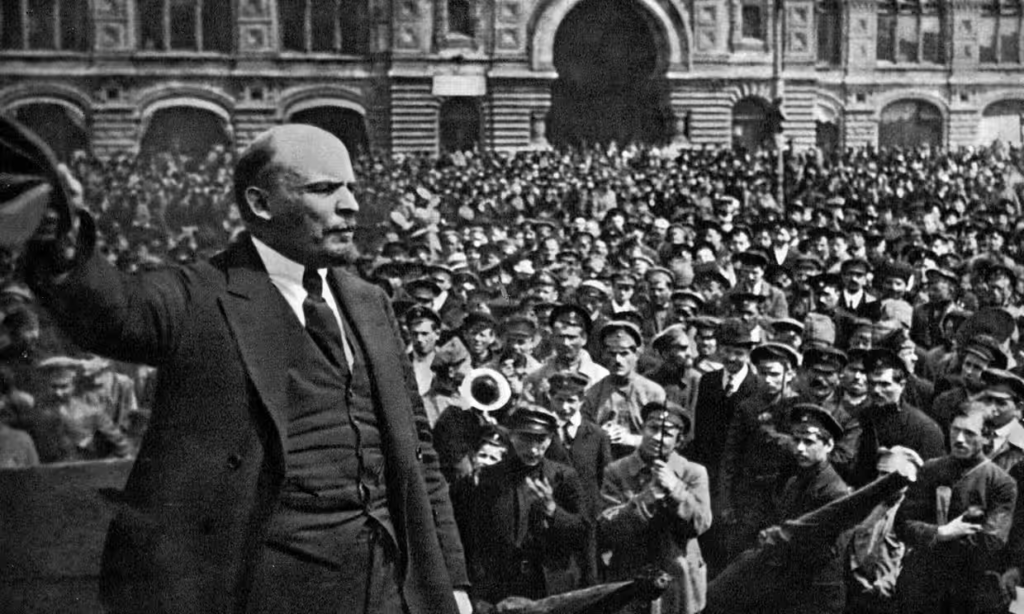
In November 1917 (October in the old Russian calendar), the communists “the Bolsheviks” captured the Winter Palace and the main arsenals and garrisons under the leadership of Lenin. He promised “peace, bread and land” to the Russians.
However, Russia lacked a mature enough working class that could carry Lenin’s communist ideals.
1918-1922 : Russian civil war won by the Bolsheviks
The Brest-Litovsk treaty that brought peace with Germany made Russia give up large swathes of its territory.
A group of army generals unhappy with it endeavoured to put an end to Lenin’s regime. They were called “the Whites” and the UK, the US, France and Japan supported their enterprise. On top of that, inflation was such that hunger killed many in Russian cities, various nationalist movements emerged in non-Russian parts of the country, and the rivalry between communists and socialists intensified.
That’s why Lenin adopted a new policy called “war communism”: executive orders circumvented democratic institutions, grain was requisitioned by force and a political police “the Cheka” was established.
During the civil war, which opposed “the Whites” and “the Reds”, 12 million people died, mainly from hunger and diseases.
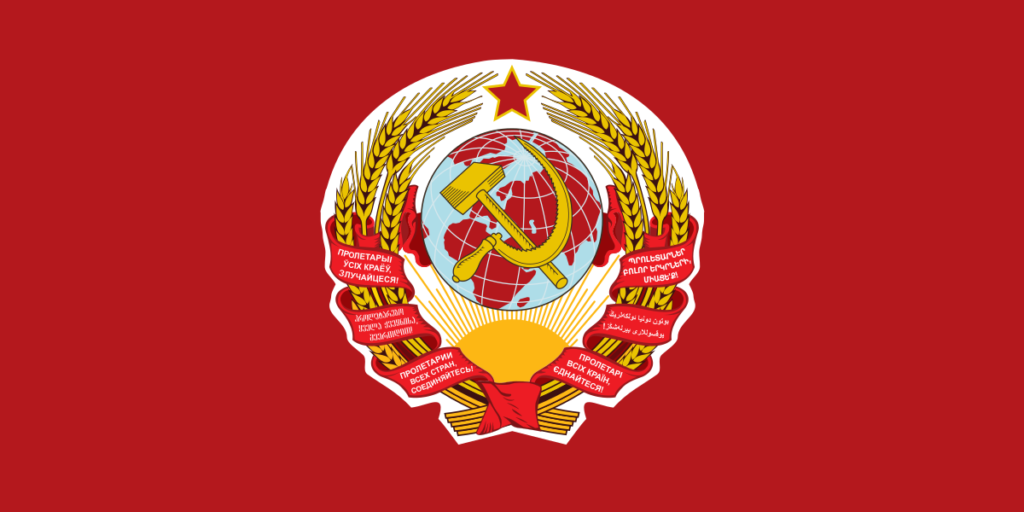
1924 : Death of Lenin
In 1922, Lenin started suffering from apoplexy and disappeared from the political scene. Before dying, he expressed his concern about the repressive and police State he had established as well as about the rise of Stalin within the communist party (he became General Secretary in 1922).
1936-1938 : Great Terror, purge of the communist party and of the army
When Stalin rose to power, he initiated the industrialisation of the country, which included collectivisation of agriculture, nationalisation of lands and turning farmers into State employees. Any kind of resistance was crushed. For instance, the regime organised a famine in Ukraine in 1932-1933 and killed more than 3 million people. It also deported millions more to working camps (Gulag).
Terror was also felt within the communist party where 75% of the representatives elected at the Party Congress in 1934 died before 1939. Likewise in the Red Army where 90% of the generals were killed or deported.
1939 : German-Soviet Pact
Stalin sought to gain time to prepare the war against Nazi Germany.
1941-1945 : Great Patriotic War
Despite the information received from his spies, diplomats and generals, Stalin refused to believe that Germany would invade but that’s what happened in June 1941 with Operation Barbarosa.
According to estimates, Russia lost around 27 million people during the Second World War.

1953 : Death of Stalin replaced by Khrushchev
Stalin’s successor Nikita Khrushchev criticised him in order not to be associated with the Terror.
1956 : Repression of the Hungarian revolt
1964 : Leonid Brejnev seizes power in a coup
Nikita Khrushchev’s management of the 1962 Cuba crisis and his disastrous economic policies got him more and more isolated inside the Communist Party.
Brejnev took power and established a more technocratic regime that reckoned with the various power groups within it. During his time at the head of the Communist Party (1964-1982), the country experienced political stability thanks to corruption, Russian citizens’ standards of living improved and the relationship with the West appeased (Détente period).
1968 : Repression of the Prague Spring
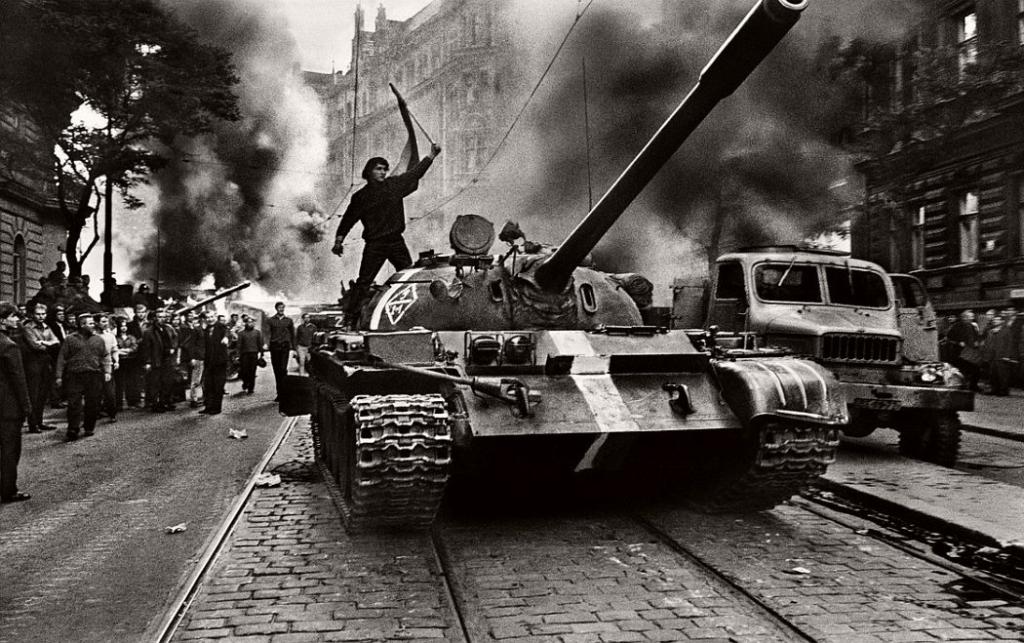
1979-1989 : war in Afghanistan
1985 : Gorbachev becomes General Secretary of the Communist Party
Throughout the 1970s, the USSR faced several economic and financial crisis and needed a quick and strong reaction from its leader, but Brejnev was unable to offer it. He died in 1982, leaving the country’s economy in shambles.
Gorbachev had the ambition to save the Soviet Union, but actually put an end to it. He launched his perestroika (restructuring) and glasnost (openness) policies so as to reform the Communist Party but was actually confronted with systemic problems for which he didn’t have enough resources and support.
1991 : End of the Soviet Union
Following months of protests and demonstrations, Gorbachev declared the dissolution of the Soviet Union on December 26, 1991.
B. Analysis
In 1812, Russia repelled Napoleon and asserted that it was the saviour of Europe, not just a latecomer. During the Second World War, it proved it. However, with the Cold War and its iron curtain, the USSR isolated itself from Europe and definitely became the “Other”.
In September and October 1991, Gorbachev asked the West for money in order to fund the Soviet Union’s budget. However, G7 countries made sure that Russia would repay all the debts it owed them… We should also mention that Gorbachev didn’t launch much needed market reforms and didn’t address issues of tax collection. Besides, the 14 other Soviet republics refused to pay their debt to Russia because they deemed that Russia had to take responsibility for it.
VIII. ‘Russia has been lifted back off its knees’ (21st century)
A. Timeline
1991 : End of the Soviet Union
The Russian Federation had to reinvent itself and answer the following question: should it restart from scratch or should it link itself to a certain history (the tzarist empire, the Soviet Union…)? It also wondered whether it could integrate Europe and be accepted into the international order dominated by the West.
Yeltsin, who was an alcoholic despised by most international leaders, led an accelerated transition from a State-controlled economy to a market economy. Capitalists took advantage of this anarchical liberalisation and State monopolies turned into private monopolies while the rest of the population suffered from poverty, rampant criminality and a dysfunctional health care system.
1994-1996 : First war in Chechnya
1998 : Financial crisis
1999-2009 : Second war in Chechnya
2000 : Vladimir Putin becomes President of the Russian Federation
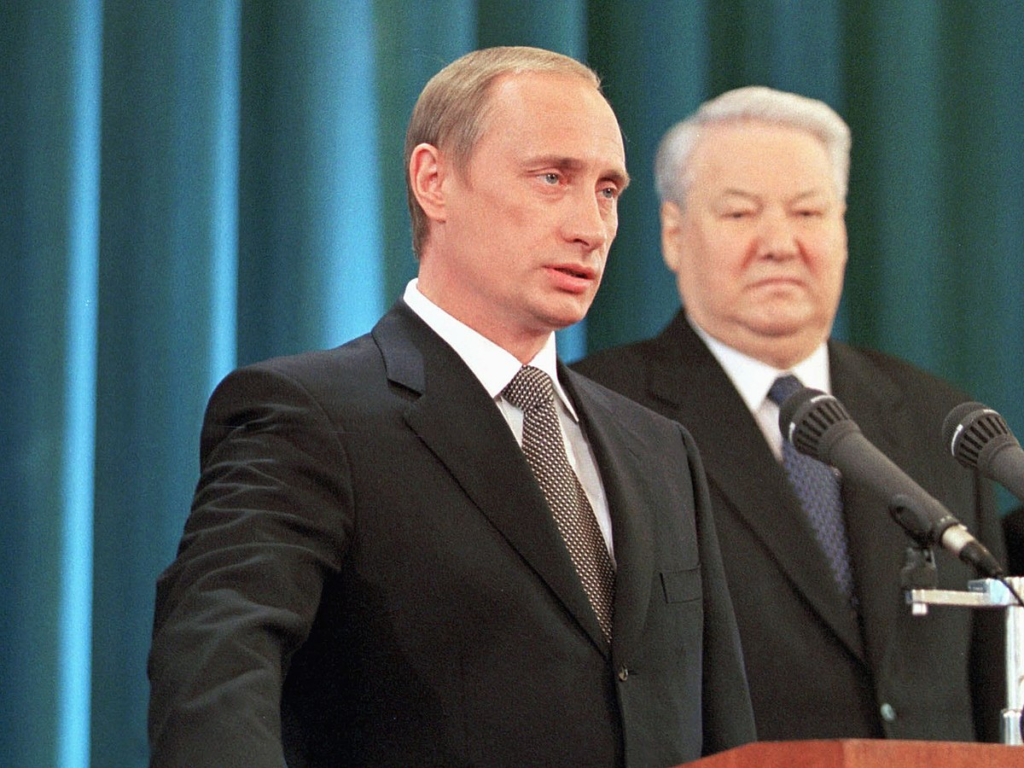
Yeltsin quit the presidency in 2000 and Putin replaced him. He got elected with a program based on law and order, which seduced most Russians that were fed up with the state of anarchy that characterised the 1990s under Yeltsin.
During the 2000s, Russia experienced a substantial rise of its GDP supported by oil and gas exports (75% of total exports and 50% of the State budget). There was then a sort of tacit agreement between Putin and the population: if they looked past his political business, they would enjoy a steady increase of their living standards. Given the years of economic despair and misery under the Soviet Union and Yeltsin’s presidency, the Russians accepted Putin’s trade-off.
2003 : Arrest of Mikhail Khodorkovsky
Mikhail Khodorkovsky was the richest Russian oligarch of the 1990s but he supported political leaders of the opposition and complained about corruption. As a result, he got arrested and put in jail.
2008 : Invasion of Georgia
In front of what Putin saw as an attempt by the West to isolate Russia and denies its status of global power, he launched various operations in Estonia (2007), Georgia (2008), Ukraine (2014), Syria (2015) and ordered murders of dissidents like journalists and former spies.
Putin’s regime is fundamentally conservative because according to him Russia’s biggest weakness is its internal divisions that are created and exploited by foreign powers.
2008-2012 : Interregnum of Medvedev
Since Putin was president in 2000-2004 and 2004-2008, he couldn’t run for a 3rd consecutive time in 2008. Therefore, Medvedev became his proxy president while he occupied the role of primer minister. In 2012, they switched offices as Putin got elected president again with 64% of the suffrage.
2014 : Annexation of Crimea and intervention in the Donbass / degradation of the relations with the West
B. Analysis
Russian leaders have long tried, still to this day, to mould the way Russians perceive themselves by altering history, highlighting some periods and ignoring others. They have always been confronted with the difficulty to build a national identity and unify a people that doesn’t have clear geographical, cultural and ethnic borders.
By building Russia’s identity in opposition to the West, Putin lets the rest of the world define him, his regime and his country.
The Russian population is receptive to Western cultural influence though, and Russian leaders’ assertion that Russia is not westernising itself is a myth, once again.



1 Comment
TURKEY and RUSSIA : a strategic alliance ? – geopol-trotters · 22 September 2023 at 6:30 am
[…] the 16th to the 20th century, the relation between Turkey and Russia boiled down to the Russo-Turkish wars. During the 16th and the 17th centuries, the Ottoman Empire laid its hands on the shores of the […]